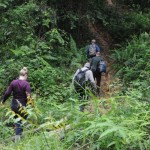
Photo credit: Ewan Hitchcoe
In July 2016, a group of undergraduate students travelled to Indonesia as part of the ‘Landscape Ecology and Primatology’ (LEAP) research project. For many it was their first experience of living and working in the tropics. Below, Ecology and Wildlife Conservation student, Ewan Hitchcoe shares some insights into the trip.
For more information about the LEAP project, take a look at the latest edition of the Bournemouth Research Chronicle.
The first part of the trip was based at the Ketambe Forest research centre, located in Aceh province. The forest here is part of the network of forests that makes up the Gunung Leuser National Park. The Ketambe research centre was built by Dr. Herman D. Rikjsen, a Dutch researcher, in 1971 and was the first Orang-utan research station in the world. Since its inception, the station has provided a base for many scientific studies carried out by well-known Orang-utan field researchers and their collaborators. The long-term nature of the station means that it’s been possible to carry out studies that help both the public and scientific community with an understanding of adaptive strategies, life history variables and social behaviour of animal populations.
Our group of BU students spent a total of 4 days at Ketambe, one half of the group staying at the research station for two days and the other half staying across the nearby river at a guesthouse, before swapping over. Ketambe was our first introduction to the rainforest and much of our time was spent on extended treks through the forest where we were lucky enough to experience a multitude of flora and fauna including many old growth trees, insects, birds and primates, as well as stunning forest landscape features such as rivers and waterfalls. Both groups were lucky enough to see wild Orang-utans at Ketambe – a mother and a young infant.
Here at Ketambe, we learned field skills, such as how to use the audio array method (spatial explicit capture-recapture) for assessing primate population density. This involved a 4am start and trekking into the forest, where we set up 3 different listening stations from which to record the morning calls of Orang-utans, Siamangs, Gibbons and Thomas leaf monkeys. We took note of the time, species, bearing and approximate distance, so that we could triangulate primate group positions later back at camp. We also learned some other techniques for monitoring bio diversity such as butterfly trapping and handling under the instruction of MRes student and LEAP team member Emma Hankinson.
After a pit stop back at Medan our next destination was at Serbajadi Aceh Timur to meet with Tezar Pahlevie and the elephant handlers of the Aceh Conservation Response Unit (CRU). Here we learned how this dedicated team use low tech methods such as fireworks or planting citrus crops to try to dissuade elephants away from people and crop plantations. We also learned how as a last resort the CRU uses trained elephants (taken from the wild as ‘problem’ elephants that would have most likely come to harm from farmers trying to protect their crops) to fight and effectively scare off wild herds. We were also privileged enough to be able to engage with the elephants by helping to wash and feed these magnificent creatures, becoming acutely aware of how truly powerful they are.
The next day we were invited to Leuser Conservation Forum offices, where Rudi Putra and Tezar Pahlevie gave us a presentation about the excellent work being carried out in Aceh and beyond. The presentation stressed the importance of and many reasons for protecting the rain forest. We learned about their success stories, as well as some of the problems that hinder the team’s progress. The biggest recurring theme is a severe shortage of and sometimes misappropriation of government funds. In a developing nation often struggling to provide housing, water, healthcare and education for its citizens, habitat and wildlife conservation is understandable not at the top of the government’s priority list. It quickly became clear that the issues faced here and throughout Indonesia are daunting and are not going to be resolved easily.
The full story of Ewan’s trip to Indonesia can be read here on LEAP’s project website.
To see more of Ewan’s photos, visit his website.
The 2017 Bournemouth Research Chronicle can be seen in full here.
 Conserving wildlife and tropical habitats in Indonesia
Conserving wildlife and tropical habitats in Indonesia Sounds of the Rainforest
Sounds of the Rainforest










 BU PhD student attending HIV conference on scholarship
BU PhD student attending HIV conference on scholarship ESRC SWDTP – Applications open for PhD Studentships for September 2026
ESRC SWDTP – Applications open for PhD Studentships for September 2026 New paper by CMWH PhD student
New paper by CMWH PhD student Further CMWH contributions to 2026 ICM congress
Further CMWH contributions to 2026 ICM congress ECR Funding Open Call: Research Culture & Community Grant – Apply Now
ECR Funding Open Call: Research Culture & Community Grant – Apply Now MSCA Postdoctoral Fellowships 2025 Call
MSCA Postdoctoral Fellowships 2025 Call ERC Advanced Grant 2025 Webinar
ERC Advanced Grant 2025 Webinar Horizon Europe Work Programme 2025 Published
Horizon Europe Work Programme 2025 Published Horizon Europe 2025 Work Programme pre-Published
Horizon Europe 2025 Work Programme pre-Published Update on UKRO services
Update on UKRO services European research project exploring use of ‘virtual twins’ to better manage metabolic associated fatty liver disease
European research project exploring use of ‘virtual twins’ to better manage metabolic associated fatty liver disease